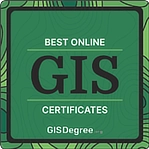Graduate School
Dr. Esra Ozdenerol & UofM: #15 GIS Certificate Ranking in the US
 On Thursday, September 28, 2023, the University of Memphis celebrated a remarkable
achievement as faculty member Dr. Esra Ozdenerol proudly announced the University of Memphis’ #15 ranking in the "Best Online GIS Certificates Guide for
2023-2024." This accolade highlights the incredible success of the Geographic Information Systems
(GIS) Certificate program, demonstrating the hard work and dedication of faculty,
staff, and students in delivering a top-tier GIS education.
On Thursday, September 28, 2023, the University of Memphis celebrated a remarkable
achievement as faculty member Dr. Esra Ozdenerol proudly announced the University of Memphis’ #15 ranking in the "Best Online GIS Certificates Guide for
2023-2024." This accolade highlights the incredible success of the Geographic Information Systems
(GIS) Certificate program, demonstrating the hard work and dedication of faculty,
staff, and students in delivering a top-tier GIS education.
A Journey of Dedication and Achievement
Dr. Ozdenerol, as the founding director of the traditional program since 2006 and the fully online program since 2019, played a pivotal role in this achievement. She shares, "I am thrilled to announce that in the recently published 'Best Online GIS Certificates Guide for 2023-2024,' the University of Memphis has achieved a remarkable milestone by securing the #15 ranking…"
Here's a closer look at the journey, obstacles overcome, and what this accomplishment means for the UofM community:
A Remarkable History of GIS Education
Dr. Ozdenerol's association with the program began in 2006 when she founded the traditional GIS Certificate program. In 2019, she extended the program to offer a fully online version, known as UMGLOBAL, enhancing accessibility to GIS education.
Obstacles Overcome on the Path to Excellence
The program's growth and improvement faced significant challenges, each of which contributed to valuable learning experiences:
- Resource Allocation: Ensuring adequate funding, faculty, and infrastructure support proved a constant challenge.
- Faculty and Staff Development: Attracting and retaining top-notch talent in the face of competition from other institutions and organizations demanded investment in professional development.
- Curriculum Enhancement: Keeping the curriculum up-to-date in a rapidly evolving GIS field required continuous adaptation and collaboration with industry experts.
- Building Strong Partnerships: Valuable collaborations with industry, research organizations, and educational institutions played a vital role and required ongoing effort.
- Data-Driven Decision-Making: Implementing data-driven strategies and organizational change required resource allocation and commitment.
- Continuous Improvement Culture: Instilling a culture of innovation and change, though met with resistance, was essential for growth and success.
The Pride of Achievement
Dr. Ozdenerol expresses immense pride in the high ranking, attributing it to several key factors:
- Faculty and Staff Dedication: The commitment of faculty and staff to providing top-quality education and fostering a supportive learning environment for students. She states the following, “I would like to express my sincere gratitude to the faculty in the Earth Sciences who contributed to GIS curriculum, Angela Antipova, Dr. Youngsang Kwon, my department chair Dr. Arleen Hill, graduate program coordinator Dr. Andrew Mickelson and Memphis Area Geographic Information Council, GIS professionals of our mid-South community partnering with us providing our students and alumni GIS internships and employment. It is through your hard work and dedication that we have achieved this significant milestone.”
- Exceptional Students and Alumni: Student and alumni success in the GIS field is a testament to the program's impact.
- Continuous Improvement: Regular curriculum assessment, innovative teaching methods, software upgrades, and feedback from students ensure the program stays at the forefront of the GIS field.
- Strong Partnerships: Collaborations with industry, research institutions, and local organizations offer unique opportunities, internships, and resources to students.
In essence, this high ranking is the result of collective efforts, demonstrating the program's commitment to excellence and the empowerment of students for successful GIS careers.
Future Opportunities and Plans
The high ranking opens up doors to numerous opportunities for students and the field of GIS:
- Enhanced Career Prospects: More prominent and diverse career opportunities for graduates in the geospatial fields.
- Expanded Research and Innovation: Cutting-edge research projects and experiential learning opportunities through industry collaborations.
- Professional Development and Networking: Connection with GIS professionals, networking events, internships, and mentorship programs.
- Alumni Engagement: Stronger alumni relationships through networks and resources.
- Outreach and Community Impact: Offering GIS workshops, seminars, and resources to the local community.
- Collaborative Initiatives: Creating joint programs, research initiatives, and academic exchanges with other institutions, nationally and internationally.
- Student Leadership and Engagement: Empowering students to lead GIS projects, conferences, and initiatives.
This ranking acts as a catalyst for additional opportunities to enrich the educational experience, advance the GIS field, and prepare students for promising careers.
Future Plans for the Program
The program's vision for the future includes:
- GIS and Health Track: Exploring the creation of a GIS and Health track for students, focusing on applications in public health, epidemiology, healthcare planning, and disease mapping.
- Drone Mapping Track: Developing a track that teaches the use of drones and unmanned aerial vehicles for data collection, mapping, and spatial analysis.
- Interdisciplinary Collaborations: Fostering partnerships with other departments and institutions to provide students with a wider range of expertise and diverse perspectives.
- Professional Development and Industry Engagement: Enhancing industry engagement, networking events, and internships with local organizations.
- Sustainability and Environmental Focus: Emphasizing the use of geospatial technology for environmental monitoring, conservation, climate change, and sustainable resource management.
- Global Opportunities: Expanding international student participation to offer a broader worldview.
- Alumni Involvement: Involving alumni in mentorship programs, career fairs, and networking events.
These plans ensure the program remains at the forefront of the GIS field, meeting evolving demands and staying relevant and competitive.
Achieving Excellence through Dedication
 While the #15 ranking may not have been the initial goal, it's a testament to the dedication, hard work,
and commitment of the UofM GIS Certificate program's faculty, staff, and students. Achieving such recognition affirms the program's
mission to provide top-tier education and serve as a valuable resource to the GIS
community.
While the #15 ranking may not have been the initial goal, it's a testament to the dedication, hard work,
and commitment of the UofM GIS Certificate program's faculty, staff, and students. Achieving such recognition affirms the program's
mission to provide top-tier education and serve as a valuable resource to the GIS
community.
The accolade doesn't mark the end of the journey but acts as a source of motivation to continue pushing boundaries and striving for continuous improvement. This remarkable achievement sets the stage for the future, filled with new opportunities and possibilities for the GIS program, its students, and the broader field of study.
